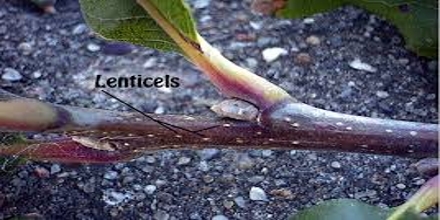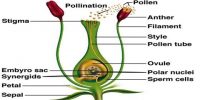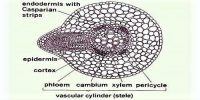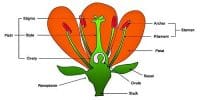On the bark of woody plants, there are some lens-shaped or egg-shaped pores present called lenticels. It functions as a pore allowing for the interchange of gases between the interior tissue and the surrounding air. Lenticels are the pores of outer plant tissue that provide a direct exchange of gases between internal plant tissues and the atmosphere.
Lenticel is a body of cells shaped on the periderm of a stem, appearing on the surface of the plant as a lens-shaped spot, and serving as a pore. A lenticel is one of many raised pores in the stem of a woody plant that allows gas exchange between the atmosphere and the internal tissues. It allows the replace of gases between the outer environment and the internal tissue of the stem.
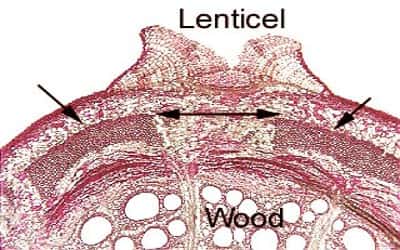
Formation:
(i) For the convenience of gaseous exchange cork cambium, in different places, produces thin-walled round parenchymatous cells instead of cork tissue. Lenticels are also formed on some fruits e.g. the small dots on the surface of apples and pears are lenticels.
(ii) Due to the formation of parenchymatous cells, cell division occurs rapidly in them. Thus, the pressure falls on epidermal tissue and the epidermal cells rupture and forms lens-shaped pores.
(iii) The parenchymatous cells below the lens-shaped pores are known as complementary cells. These lens-shaped pores and the area of complementary cells lying below the lens-shaped pores are known as lenticels.
(iv) Lenticels are characteristics of the woody stem. It is a tiny raised pore, typically elliptical in nature. They help in gaseous exchange and transpiration. It develops in woody stems when the epidermis is replaced by a cork (or bark).
(v) On the surface of the stem or root, the lenticels appear as raised circular, oval, or elongated areas that look like small eruptions in the bark. The complementary a cell is oval in shape and is thinly walled loosely arranged with large intercellular spaces.
(vi) Lenticels begin to form during development of the first periderm and, in the stem, generally, appear below a stoma or group of stomata. Its structure generally begins beneath stomatal complexes during major growth preceding the development of the first periderm.
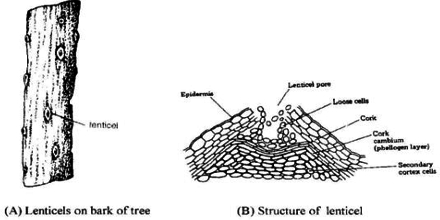
Function;
It functions as a pore allowing for the interchange of gases between the interior tissue and the surrounding air. Internal plant tissue is impermeable to gases without lenticel. It functions as a pore, providing a way for the straight exchange of gases between the internal tissues and atmosphere through the bark, which is otherwise impermeable to gases. It functions as a pore allowing for the interchange of gases between the interior tissue and the surrounding air.
(i) The lenticels help in the gaseous exchange between the atmosphere and the internal tissue of the stem. The main function of lenticel is to perform a gaseous exchange between air and inner tissues.
(ii) Often a little transpiration may occur through lenticels. The lenticels also help in transpiration called as the lenticular transpiration. It allows gas exchanges between the atmosphere and internal tissues of the plant.
(iii) Lenticels like Stomata help in transpiration. Called Lenticular transpiration. The lenticular transpiration occurs when the stomata close.
(iv) Lenticels are active during the night when stomatal transpiration stop. The lenticels help in allowing the oxygen into and carbon dioxide out. The lenticels also help in transpiration called as the lenticular transpiration.
(v) Lenticels are active during the night when stomatal transpiration stops. In plant bodies that produce secondary growth, lenticels promote the gas exchange of oxygen, carbon dioxide, and water vapor. It functions as a pore, providing a medium for the direct exchange of gases between the internal tissues and atmosphere.
